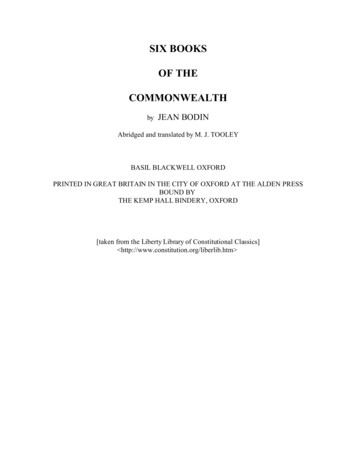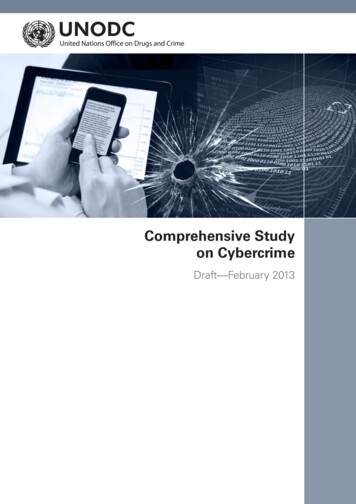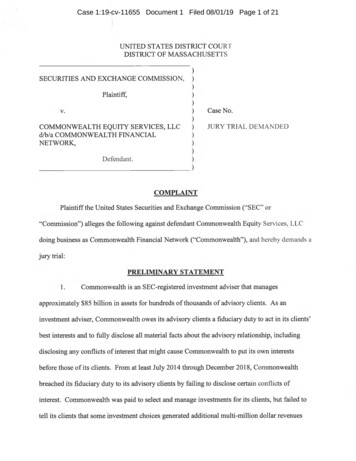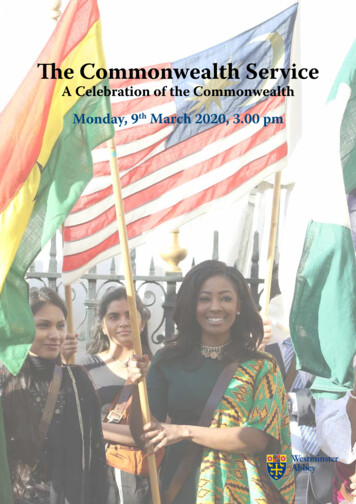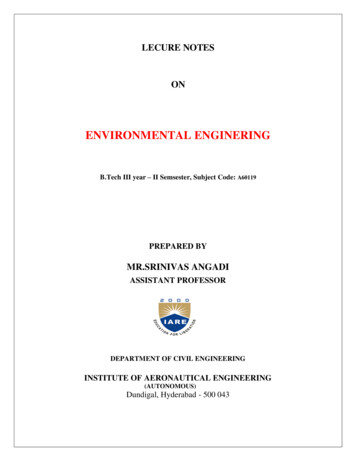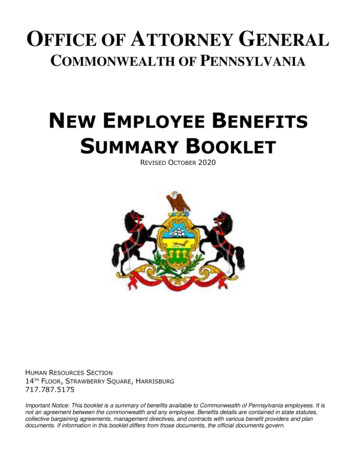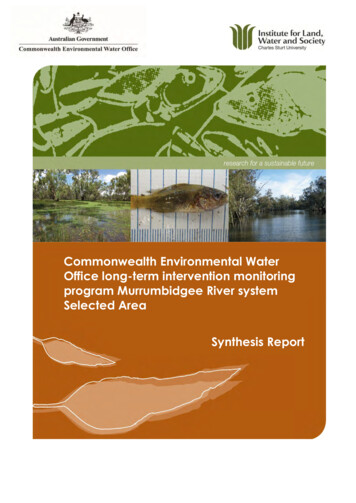
Transcription
PortCommonwealth Environmental WaterOffice long-term intervention monitoringprogram Murrumbidgee River systemSelected AreaSynthesis Report
Commonwealth Environmental Water Office long-term interventionmonitoring program Murrumbidgee River system Selected Area, 2014-15Synthesis report. January 2016Prepared by: Wassens, S.a, Bino, G.b, Spencer, J.c, Thiem, J.d, Wolfenden, B.a,Jenkins, K.a, Thomas, R.c, Hall, A.a, Ocock, J.c, Lenon, E.f, Kobayashi, Tc, Heath,J. c and Cory, Fe.Institute for Land, Water and Society. Charles SturtUniversity, PO Box 789, Albury, NSW 2640ab Centrefor Ecosystem Science, University of New SouthWales, Sydney, NSW, 2052Water and Wetlands Team, Science Division, NSWOffice of Environment and Heritage, PO Box A290,Sydney South, NSW 1232cd NSWTrade and Investment Narrandera FisheriesCentre, PO Box 182, Narrandera NSW 2700Murrumbidgee Local land Services, Level 1, 42-45Johnston Street (PO Box 5224). Wagga Wagga NSW2650eCommonwealth Environmental Water OfficePO Box 156, Leeton NSW 2705 AustraliafThis monitoring project was commissioned and funded by Commonwealth Environmental Water Officewith additional in-kind support from the NSW Office of Environment and Heritage, Murrumbidgee Localland Services, and Charles Sturt University. We are grateful to private landholders for allowing access totheir properties.Copyright Copyright Commonwealth of Australia, 2016‘Commonwealth Environmental Water Office long-term intervention monitoring program MurrumbidgeeRiver system Selected Area, 2014-15 Synthesis report ‘ is licensed by the Commonwealth of Australia foruse under a Creative Commons By Attribution 3.0 Australia licence with the exception of the Coat of Armsof the Commonwealth of Australia, the logo of the agency responsible for publishing the report, contentsupplied by third parties, and any images depicting people. For licence conditions This report should be attributed as ‘Commonwealth Environmental Water Office long-term interventionmonitoring program Murrumbidgee River system Selected Area, Synthesis report, Commonwealth ofAustralia 2016’. The Commonwealth of Australia has made all reasonable efforts to identify contentsupplied by third parties using the following format ‘ Copyright, [name of third party] ’.DisclaimerThe views and opinions expressed in this publication are those of the authors and do not necessarilyreflect those of the Australian Government or the Minister for the Environment.While reasonable efforts have been made to ensure that the contents of this publication are factuallycorrect, the Commonwealth does not accept responsibility for the accuracy or completeness of thecontents, and shall not be liable for any loss or damage that may be occasioned directly or indirectlythrough the use of, or reliance on, the contents of this publication.
1 Executive summaryIn this report we evaluate the extent to which Commonwealth in combination withState environmental watering actions achieved the outcomes defined in both theMurrumbidgee Monitoring and Evaluation Plan (Wassens, Jenkins et al. 2014) and theCommonwealth Environmental Water Office 2014-15 annual watering plan.Evaluations were undertaken with respect to riverine productivity and water quality,river and wetland fish communities, riverine larval fish, riverine and wetlandmicroinvertebrates, wetland vegetation, frogs and tadpoles and waterbirds. A widerange of watering activities, targeting multiple aquatic ecosystems were undertakenusing a combination of Commonwealth and State environmental water holdings.Three of these watering actions are evaluated in this report. These relate urrumbidgeeTherewerenoenvironmental watering actions undertaken in the Murrumbidgee River, althoughsignificant volumes of environmental water in transit to target assets in theLowbidgee floodplain may have secondary benefits for in-channel environments.Monitoring in the Murrumbidgee River provides a baseline on ecological responseundertaken during normal river operations, including the delivery of water forirrigation, consumptive and environmental purposes.Managed environmental watering was the primary mechanism by which wetlandsand floodplains in the Murrumbidgee received water in 2014-15. In combination withState agencies, Commonwealth environmental watering actions made a highlysignificant contribution to ecological outcomes across the monitoring zones. Theseincluded the successful re-establishment of spiny mud grass at Yarradda Lagoon inthe mid-Murrumbidgee, establishment of diverse aquatic vegetation communitiesthrough the Lowbidgee floodplain, promotion of successful breeding by frogs,including the southern bell frog which is listed as vulnerable under theCommonwealth Environmental Protection and Biodiversity Conservation Act 1999(EPBC Act 1999) in the Nimmie-Caria and establishment of highly ommunitiesoffilter-feedingwaterbirds. Return flows in the Lowbidgee floodplain also contributed toimprovements in water quality across the river red gum wetlands, reducing the risks1
of future hypoxic blackwater events. While there were no targeted environmentalwatering actions in the Murrumbidgee River, the monitoring project identifiedspawning by key native fish species including golden and silver perch (criticallyendangered, EPBC Act), cod species (Murray cod (vulnerable EPBC Act) and troutcod (endangered, EPBC Act)) and Australian smelt as well as extremely highdensities of microinvertebrates.For other indicators, waterbird diversity was low at monitored sites compared toprevious years, reflecting the relatively small volumes of water utilised during 2014-15.While southern bell frog populations remain in the Nimmie-Caria, there has been acontinued decline of southern bell frog populations through the Redbank system.Key recommendationsThe Murrumbidgee LTIM monitoring program considerers only a very small fraction rea,specificrecommendations provided are therefore restricted to four habitat types, persistentoxbow lagoons in the mid-Murrumbidgee, lignum-black box wetlands through theNimmie-Caria, River red gum spike rush wetlands in the Redbank system and inchannel habitats in the mid-reaches of the Murrumbidgee River. There are a few keyrecommendations that could be undertaken to maximise positive ecological,cultural and community outcomes during environmental watering actions.Identify and maintain persistent off-river refuges and then forward allocateenvironmental water to maintain persistent refuges even during years of very lowwater availability.The 2014-15 monitoring program identified persistent off-channel refuges as beingcritical for native fish, freshwater turtles and frogs. Forward allocating environmentalwater to maintain persistent refuges even during years of very low water availabilitywill help support populations of native floodplain species, such as the southern bellfrog.2
Maintain viable southern bell frog populationsThe continued decline of southern bell frog populations noted in 2014-15 is a seriousconcern and watering actions specifically targeting this federally listed speciesshould be a priority. Target watering actions to maintain and recover southern bellfrog populations through the Nimmie-Caria floodways including Telephone Creek,Eulimbah and Suicide Swamp, Avalon Swamp and Nap Nap Swamp. It is critical tonote that the LTIM monitoring only covers a small fraction of potential southern bellfrog habitats through the Lowbidgee floodplain, other opportunities for wateringactions to maintain southern bell frog habitat should also be explored. It is importantto note that mapping of southern bell frog population through the Murrumbidgeehas been carried out in various areas by a range of different groups, but this datahas not been consolidated into a form that could be used to direct watering actionsacross the catchment.Support waterbird breeding and habitats in the mid- and Lowbidgee floodplainThe Murrumbidgee supports many south eastern Australia’s key waterbird breedingsites, key sites across the Nimmie-Caria floodway including Eulimbah, Suicide,Telephone Creek, Nap Nap Swamp are critical rookery sites for colonial nestingwaterbirds with up to 60 000 birds breeding through these wetlands in 201011(Brandis, Ryall et al. 2011). However, over the past three decades the frequencyand size of waterbird breeding events have declined through the Murrumbidgee.While small colonises of fish eating waterbirds have established over recent years, nowaterbird breeding were recorded in 2014-15 at the LTIM monitoring sites andwaterbird diversity in general was low compared to previous years. Preliminaryanalysis of past breeding events through the Lowbidgee floodplain have shown thatthe probability of successful breeding by colonial nesting waterbird speciesincreases with increasing inundation area, with approximately 40,000ha ofinundation required to trigger successful breeding by colonial nesting waterbirdspecies (Wassens, Jenkins et al. 2014).To achieve these volumes, contingencyallowances can be used to support colonial waterbird breeding in the MidMurrumbidgee, Nimmie-Caira and Redbank zones to ensure colony sites andsurrounding foraging habitats are flooded for long enough to allow birds to raise andfledge their young successfully. In the Nimmie-Caria aim to achieve 40,000ha of3
habitat consisting of smaller areas of persistent stable water levels through therookery sites, for example Nap Nap, Telephone Creek, Eulimbah and Suicide Swampintegrated within a with a mosaic of less persistent, high productivity foraginggrounds. To achieve this level of inundation it may be necessary to include areasagent to the floodway’s where lignum has been previously cleared.Where possible, time these environmental flows in the Murrumbidgee Selected Areato inundate wetlands over late winter through spring and summer to coincide withpeak activity of most waterbird species. With the rookery sites being maintainedthrough spring and summer. Note that this watering actions is likely to providesignificant benefits for other waterbird species (waterbird diversity) vegetationdiversity, frogs and turtles (other vertebrate diversity) through the Nimmie-Cariafloodplain.Recovering wetland vegetationVegetation communities in the Lowbidgee floodplain are diverse and rumbidgeevegetationcommunities at the two wetlands that received environmental water are improving,with increased diversity and percent cover of aquatic species, however the majorityof wetlands in the mid-Murrumbidgee are in very poor condition with a highproportion of introduced terrestrial species. Many are also subject to river red gumencroachment. Reinstating the natural hydrological regime to wetlands in the midMurrumbidgee floodplain, with seasonal inundation and occasional, brief dryingperiods, is critical for the restoration of aquatic vegetation communities andassociated wetland fauna.Increase water depth and duration in wetlands impacted by river red gumencroachment to facilitate selective thinning of river red gum seedlings, for seriouslyimpacted wetlands such as McKenna’s lagoon, permanent inundation for periods ofup to three years may be required (Roberts and Marston 2011).4
2 Murrumbidgee Long Term Intervention MonitoringProjectThe Commonwealth Environmental Water Holder (CEWH) is responsible under theWater Act 2007 (Commonwealth) for managing Commonwealth environmentalwater holdings. The holdings are managed to protect and restore the environmentalassets of the Murray-Darling Basin, and other areas where the Commonwealth holdswater, so as to give effect to relevant international agreements. The Basin Plan(2012) further requires that the holdings must be managed in a way that is consistentwith the Basin Plan’s Environmental Watering Plan. The Water Act 2007 and the BasinPlan also impose obligations to report on the contribution of Commonwealthenvironmental water to the environmental objectives of the Basin Plan.Monitoring and evaluation are critical for achieving effective and efficient use ofCommonwealth environmental water. They provide important information tosupport the CEWH’s reporting obligations in addition to demonstrating overalleffectiveness at meeting conservation objectives.The Long-Term Intervention Monitoring Project (LTIM Project) is the primary frameworkby which the Commonwealth Environmental Water Office (CEWO) will undertakemonitoring and evaluation of the ecological outcomes of Commonwealthenvironmental watering and its objectives. The LTIM Project is implemented at sevenselected areas over a five year period from 2014-15 to 2018-19 to deliver five highlevel outcomes (in order of priority): Evaluate the contribution of Commonwealth environmental watering to theobjectives of the Murray-Darling Basin Authority’s (MDBA) EnvironmentalWatering Plan Evaluate the ecological outcomes of Commonwealth environmentalwatering at each of the seven selected areas Infer ecological outcomes of Commonwealth environmental watering inareas of the Murray-Darling Basin not monitored Support the adaptive management of Commonwealth environmental water Monitor the ecological response to Commonwealth environmental wateringat each of the seven selected areas.5
This synthesis report outlines the ecological outcomes of environmental wateringactions in the Murrumbidgee selected area undertaken in 2014-15, the first year ofthe five year LTIM project. This report draws on information presented in theMurrumbidgee Monitoring and Evaluation Plan (Wassens, Jenkins et al. 2014) and iscomplemented by the Murrumbidgee Long-Term Intervention Monitoring 2014-15Technical report (hereafter referred to as the “technical report”), which provides acomprehensive assessment of ecological outcomes to environmental flows in theMurrumbidgee Selected Area in 2014-15 including details on data analysistechniques and statistical outputs.3 Summary of monitoring activities -MurrumbidgeeSelected AreaOver 1,000 wetlands make up more than 4% (370,000 ha) of the MurrumbidgeeCatchment (Murray 2008). Nationally important wetlands, including the midMurrumbidgee and Lowbidgee floodplain, cover over 208,000 ha (2.5% of the totalcatchment area)(Hardwick and Maquire 2012). Monitoring activities under thecurrent project occur within broad ecological zones (zones) that represent areaswith common ecological and hydrological characteristics.In the Murrumbidgee River, monitoring activities are undertaken within three zones,Narrandera (187 km), Carrathool (358 km) and Balranald (241 km) (Figure 1). Themajor monitoring emphasis is on the Narrandera and Carrathool zones. Monitoring inthe Murrumbidgee River consists of six core monitoring locations in the Narrandera (3sites) and Carrathool (3 sites) zones targeting larval fish, microinvertebrates, nutrients,carbon and Chlorophyll-a, with additional sites making up the fish communitymonitoring locations (Table 1; see Figure 1).On the floodplain six ecological zones have been identified; the mid-Murrumbidgeewetlands (82,800 ha), Redbank (92,504 ha), Nimmie-Caira (98,138 ha), Pimpama–Wagourah (55,451 ha), Fiddlers-Uara (75,285 ha), and Western Lakes (3,459 ha)(Wassens, Jenkins et al. 2014). The LTIM project includes 12 fixed wetland sitesfocused on three zones; the Redbank (4 sites), Nimmie-Caira (4 sites) and the midMurrumbidgee (4 sites) (See Figure 1, Table 2). The wetland monitoring y,frogs,fishcommunity,6
microinvertebrates, nutrients, carbon and chlorophyll-a with monitoring undertakenfour times per year in September 2014, November 2014, January 2015 and March2015.Plate 1 Aquatic vegetation at Two Bridges Swamp in the Redbank zone, March 20157
Baupile Escape(River)Glen Avon (River)MaudeNap NapRedbank WeirFish community (C3)Fish community (C1)Larval Fish SALarval fish C1MicroinvertebrateNutrients carbonStream metabolismANAE classificationZoneXBalranaldSite NameTable 1 Summary of monitoring activities and location in the Murrumbidgee River (in channelsites) (see Figure 1)XXPermanent lowland streamsXXWillow IslesXWynburnXYarradda (River)Permanent transitional zonestreamsXXXXXXXXXXXXXXXXXXBirdcageXXGundaline claybarXGundaline USXMcKennas (River)XHay Boat RampPevenseyRudds PointCarrathoolBringageeXPermanent lowland streamsXXToganmain DSXToganmainHomesteadToganmain USXXWyreemaXXXXXEuroley BridgeXXXXXXXXNarranderaBuckingbongStationBerembed Weir DSGogeldrie Weir USLamonts BeachNarranderaThe DairyXPermanent lowland streamsXXXXUS upstream, DS downstream, River distinguishes site from comparable Wetland site with the samename see Table 4, C1 Category 1 LTIM standard methods, C3 Category 3 LTIM standard methods).8
Permanent floodplain wetlandXXXXXXIntermittent river red gumfloodplain swampIntermittent river red gumfloodplain swampIntermittent river red gumfloodplain swampTemporary floodplain lakesXXXXXXXXXXXXXXXXXXXXXXXXTemporary floodplain wetlandXXXXXXIntermittent river red gumfloodplain swampPermanent floodplain wetlandXXXXXXXXXXXXIntermittent river red gumfloodplain swampPermanent floodplain tallemergent marshesIntermittent river red gumfloodplain swampPermanent floodplain wetlandXXXXXXXXXXXXXXXXXXXXXXXXANAE classificationVegetation DiversityTwo BridgesSwampWaugorahLagoonWaterbird DiversityPiggery LakeRedbankMercedes SwampFrogsTelephone CreekFish community (C3)Nap Nap SwampMicroinvertebrateEulimbah SwampNimmie-CairaAvalon SwampNutrients , carbon, chl dda Lagoonmid-Murrumbidgee ZoneSite NameTable 2 Summary of monitoring activities and locations across three wetland zones in theMurrumbidgee floodplain (see Figure 1)9
Figure 1 Distribution of riverine zones (top) and wetland (bottom) zones and key monitoringlocations in the Murrumbidgee Selected Area10
4 Commonwealth environmental watering activities andecological objectives 2014-15Climate and water contextEnvironmental watering actions are determined by a combination of catchmentand climate conditions as well as the volume of water holdings. These also providethe context in which the ecosystem responses to watering can be evaluated. TheMurrumbidgee River catchment has undergone significant long-term modificationsto the dominant hydrological regime, including alterations to the timing of high flowperiods and significant reductions in the frequency of moderate and high flowevents (Frazier, Page et al. 2005, Frazier and Page 2006). Significant droughtbetween 2000 and 2010 exacerbated the effects of river regulation leading tosignificant declines in the condition of floodplain vegetation (Wen, Ling et al. 2009).Large scale flooding occurred in 2010 and 2011 which was followed by moderatewater availability between 2012 and 2014. While river flows remain relatively stable,the extent of inundation across floodplain habitats remains relatively smallcompared to conditions prior to 2000.2014-15 Watering ActionsCommonwealth environmental water use options 2014–15: Murrumbidgee Riveroutlines watering options for the use of Commonwealth environmental water in theMurrumbidgee River Valley in 2014-15 (Commonwealth Environmental Water Office2014). Nine high level water use options were identified targeting the midMurrumbidgee wetlands, Lowbidgee floodplain and the Murrumbidgee River andcreek system, under a range of hydrologic conditions. Individual actions wereidentified based on climate conditions, water availability, environmental demands,constraints and risks.The priority watering action was the mid-Murrumbidgee piggyback action. Thisaction was dependent on the occurrence of a suitably sized rainfall generated flowevent as a trigger, which did not occur at a suitable time. Mid-Murrumbidgeewatering would have delivered a range of downstream, including in-channel,outcomes. As a result, alternative uses of Commonwealth environmental water wereimplemented including pumping to isolated wetlands in the mid-Murrumbidgee,11
watering of Lowbidgee wetlands and floodplain assets and the Yanco Creeksystem.Plate 2 Telephone Creek, Nimmie-Caira zone November 201412
Table 3 2014-15 Murrumbidgee environmental water use by entitlement (updated to30/06/14) (Murrumbidgee 2014-15 Water use Acquittal Report)Water Use Volume MurrumbidgeeYancoStart – EndDateEvent Name06/07/1430/08/14Nap NapSwamp toWaugorah CkUara Creek toYangaNorth CairaFloodwaysKia Lake6301000010000Telephone BankSwampNimmie-CairaSouthern BellFrog WetlandsNimmie Creek49304930Paika 3/1501/04/15NSWAEWNSWEWACEWH GSCEWHSUPP2000NSWSUPPTotalVolumedelivered 56881035570000Mid NorthRedbank, returnflowsUpper NorthRedbankJuanbung3136Yanga NationalParkSouth Yanga62801907078855893Yanco arraddaLagoonSandy Creek130MIA wetlands24722472Coonancoocabil wetlandsOld Man Creek720720840840Gras Innes andOak Creek12781,27811501150250380Commonwealth environmental water contributed to eight watering actionswithin the Murrumbidgee Valley in 2014-15. These actions were anticipatedto achieve the following expected outcomes.13
A.B.C.D.E.F.G.protect, maintain, and in some cases improve the condition and extentof floodplain, riparian and wetland native vegetationmaintain and improve the diversity and condition of native aquaticfauna including fish, waterbirds, frogs, turtles and invertebrates throughmaintaining suitable habitat and providing/supporting opportunities tomove, breed and recruitsupport the habitat requirements of waterbirdssupport the habitat requirements of native fishsupport the habitat requirements of other vertebratessupport ecosystem functions, such as mobilisation, transport anddispersal of biotic and abiotic material (e.g. macroinvertebrates,nutrients and organic matter) through longitudinal and lateralhydrological connectivityimprove ecosystem and population resilience through supportingecological recovery and maintaining aquatic habitat.Table 4 identifies each of these watering actions and which of theseexpected outcomes relate to each of the watering actions that occurred.Three watering actions, that used Commonwealth environmental water,were monitored as part of the Murrumbidgee LTIM project in 2014-15. Theseactions were: Pumping to Yarradda Lagoon in the mid-Murrumbidgee;wetland watering in Yanga National Park (Redbank); return flows from NorthRedbank to the Murrumbidgee River Channel. There were no wateringactions specifically targeting in-channel ecological outcomes implementedin the Murrumbidgee selected area in 2014-15, although some wateringactions were undertaken outside the monitoring area in Yanco Creek. Thisreport considers ecological outcomes occurring under normal riveroperations in the Murrumbidgee selected area including flows delivered forirrigation and environmental purposes on the floodplain, and inter-valleytransfers (IVTs).14
Table 4 Summary of Commonwealth environmental watering actions and expectedoutcomes. Also see Murrumbidgee Monitoring and Evaluation plan (M&EPlan)(Wassens, Jenkins et al. 2014)Target assetExpected outcomes for 2014-15LTIM MONITORED SITES/ACTIONSYarradda LagoonPrimaryAction 2– protect and maintain wetland and riparianZonesnative vegetationMid-MurrumbidgeeSecondary(Yarradda Lagoon)– provide feeding habitat for waterbirds, nativefish, other aquatic vertebrates (turtles, frogs)and invertebrates.Mid North Redbank and Mid North RedbankReturn Flows- protect, maintain, and in some cases improve(only the return flowsthe condition and extent of floodplain, riparianwere monitored for thisand wetland native vegetationaction)- maintain and improve the diversity andAction 9condition of native aquatic fauna includingfish, waterbirds, frogs, turtles and invertebratesthrough maintaining suitable habitat andproviding/supporting opportunities to move,breed and recruit– support habitat requirements for waterbird,frog and native fishReturn flows- support ecosystem functions, such asmobilisation, transport and dispersal of bioticand abiotic material (e.g. macroinvertebrates,nutrients and organic matter) throughlongitudinal and lateral floodplain-riverconnectivityYanga National ParkPrimary- protect, maintain, and in some cases improveAction 6the condition and extent of floodplain, riparianZonesand wetland native vegetationRedbank- maintain and improve the diversity and(Mercedes, Piggery, Two condition of native aquatic fauna includingBridges, Waugorahfish, waterbirds, frogs, turtles and invertebratesLagoon)through maintaining suitable habitat andproviding/supporting opportunities to move,Nimmie-Cairabreed and recruit(Avalon, Nap Nap,– additional water supplied to supportEulimbah, Telephoneidentified waterbird (egret) breeding eventCreek)Secondary– support ecosystem functions– provide habitat for native fish, frogs and othervertebrates– support habitat requirements for waterbird,frog and native fishBasin Plan (bold) and longerterm objectives (M&E Plan)Vegetation diversityFish diversityWaterbird diversityOther vertebrate diversityMicroinvertebratesWater qualityEcosystem functionBiotic dispersal and movementSediment transportNutrient and carbon cyclingMicroinvertebratesVegetation diversityFish diversityWaterbird diversityOther vertebrate diversityMicroinvertebrates15
Table 5 continued. Summary of Commonwealth environmental watering actionsand expected outcomes. Also see Murrumbidgee Monitoring and Evaluation plan(M&E Plan)(Wassens, Jenkins et al. 2014)SITES/ACTIONS NOT MONITORED AS PART OF LTIMUpper North RedbankSandy CreekPrimary- protect, maintain, and in some cases improvethe condition and extent of floodplain, riparianand wetland native vegetation- maintain and improve the diversity andcondition of native aquatic fauna includingfish, waterbirds, frogs, turtles and invertebratesthrough maintaining suitable habitat andproviding/supporting opportunities to move,breed and recruitSecondary– support ecosystem functions– support habitat requirements for waterbird,frog and native fishVegetation diversityPrimary– protect and maintain wetland and ripariannative vegetationSecondary– provide feeding habitat for waterbirds– provide feeding habitat for frogsVegetation diversityWaterbird diversityOther vertebrate diversityWaterbird diversityFish diversityEcosystem functionWaterbird diversityOther vertebrate diversityWaterbird diversityJuanbungPrimary– water stressed river gum floodplain andriparian native vegetationSecondary– provide feeding habitat for waterbirds– provide feeding habitat for frogsVegetation diversityWaterbird diversityOther vertebrate diversityWaterbird diversityPaika LakeYanco CreekPrimary– Maintenance of open water habitat forwaterbirdsSecondary– inundate fringing aquatic vegetationcommunities– Support habitat requirements for waterbird,frog and native fishPrimary- protect, maintain, and in some cases improvethe condition and extent of floodplain, riparianand wetland native vegetation- maintain and improve the diversity andcondition of native aquatic fauna includingfish, waterbirds, frogs, turtles and invertebratesthrough maintaining suitable habitat andproviding/supporting opportunities to move,breed and recruitSecondary– Support habitat requirements for waterbird,frog and native fish– provide feeding longitudinal and lateralconnectivityVegetation diversityWaterbird diversityFish diversityWaterbird diversityVegetation diversityOther vertebrate diversityFish diversityWaterbird diversityBiotic dispersal and movement16
5 Evaluation of ecological outcomes in response toCommonwealth environmental water useSummary of Riverine hydrologyWhile no environmental watering targeted in-channel flows, delivery ofCommonwealth environmental water to floodplain habitats may havecontributed secondary benefits to in-channel habitats. It is thereforeinformative to consider the ecological outcomes in the Murrumbidgee Riverin the context of normal operations, involving irrigation, consumptive andenvironmental water deliveries to provide a baseline for future years.Monitoring was undertaken in two hydrological zones: the Carrathool Zoneand The Narrandera Zone (see Figure 2). As monitoring was undertakenfortnightly on six occasions (see Section 2, Murrumbidgee LTIM technicalreport (Wassens, Thiem et al. 2015), we used the cumulative flows (meandischarge over 14 days). Overall, cumulative flows were considerably higherin the Narrandera zone (Narrandera gauge) compared to that measured forthe Carrathool zone (Carrathool gauge) which is down stream of majorirrigation off-takes (Figure 2). In Carrathool, flows were relatively stable overthe six survey occasions between October and January, while in Narranderaflows decreased slightly in mid-December and then peaked in lateDecember 2014.17
Figure 2 Fourteen day cumulative flows [ML] in the two river zones and six surveyoccasionsSummary of wetland hydrologyThere were two watering actions targeting floodplains and wetlands in theMurrumbidgee Selected Area; Action 2 involved infrastructure assisteddelivery of water to Yarradda Lagoon in the mid-Murrumbidgee, whileAction 6 involved large-scale watering of wetlands across the Lowbidgeefloodplain. Only two of the four wetlands in the mid-Murrumbidgee receivedwatering in 2014-15,
a . Institute for Land, Water and Society Charles Sturt University, PO Box 789, Albury, NSW 2640 b Centre for Ecosystem Science, University of New South Wales, Sydney, NSW, 2052 c Water and Wetlands Team, Science Division, NSW Office of Environment and Heritage, PO Box A290, Sydney South, NSW 1232 d NSW Trade and Investment Narrandera Fisheries
